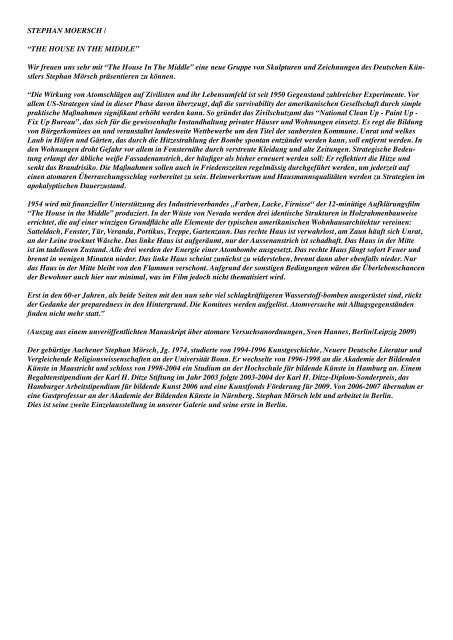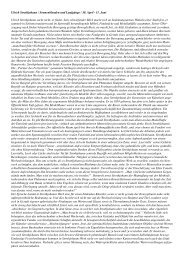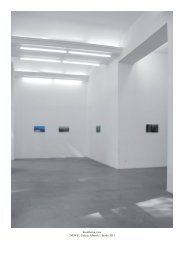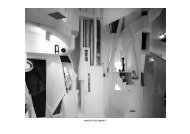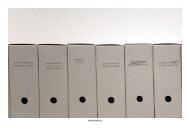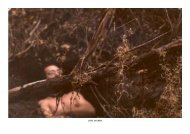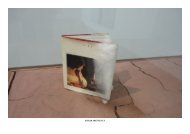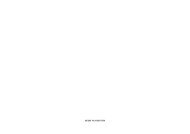STEPHAN MOERSCH - Adamski Gallery for Contemporary Art
STEPHAN MOERSCH - Adamski Gallery for Contemporary Art
STEPHAN MOERSCH - Adamski Gallery for Contemporary Art
Erfolgreiche ePaper selbst erstellen
Machen Sie aus Ihren PDF Publikationen ein blätterbares Flipbook mit unserer einzigartigen Google optimierten e-Paper Software.
<strong>STEPHAN</strong> <strong>MOERSCH</strong> /“THE HOUSE IN THE MIDDLE”Wir freuen uns sehr mit “The House In The Middle” eine neue Gruppe von Skulpturen und Zeichnungen des Deutschen KünstlersStephan Mörsch präsentieren zu können.“Die Wirkung von Atomschlägen auf Zivilisten und ihr Lebensumfeld ist seit 1950 Gegenstand zahlreicher Experimente. Vorallem US-Strategen sind in dieser Phase davon überzeugt, daß die survivability der amerikanischen Gesellschaft durch simplepraktische Maßnahmen signifikant erhöht werden kann. So gründet das Zivilschutzamt das “National Clean Up - Paint Up -Fix Up Bureau”, das sich für die gewissenhafte Instandhaltung privater Häuser und Wohnungen einsetzt. Es regt die Bildungvon Bürgerkomitees an und veranstaltet landesweite Wettbewerbe um den Titel der saubersten Kommune. Unrat und welkesLaub in Höfen und Gärten, das durch die Hitzestrahlung der Bombe spontan entzündet werden kann, soll entfernt werden. Inden Wohnungen droht Gefahr vor allem in Fensternähe durch verstreute Kleidung und alte Zeitungen. Strategische Bedeutungerlangt der übliche weiße Fassadenanstrich, der häufiger als bisher erneuert werden soll: Er reflektiert die Hitze undsenkt das Brandrisiko. Die Maßnahmen sollen auch in Friedenszeiten regelmässig durchgeführt werden, um jederzeit aufeinen atomaren Überraschungsschlag vorbereitet zu sein. Heimwerkertum und Hausmannsqualitäten werden zu Strategien imapokalyptischen Dauerzustand.1954 wird mit finanzieller Unterstützung des Industrieverbandes „Farben, Lacke, Firnisse“ der 12-minütige Aufklärungsfilm“The House in the Middle” produziert. In der Wüste von Nevada werden drei identische Strukturen in Holzrahmenbauweiseerrichtet, die auf einer winzigen Grundfläche alle Elemente der typischen amerikanischen Wohnhausarchitektur vereinen:Satteldach, Fenster, Tür, Veranda, Portikus, Treppe, Gartenzaun. Das rechte Haus ist verwahrlost, am Zaun häuft sich Unrat,an der Leine trocknet Wäsche. Das linke Haus ist aufgeräumt, nur der Aussenanstrich ist schadhaft. Das Haus in der Mitteist im tadellosen Zustand. Alle drei werden der Energie einer Atombombe ausgesetzt. Das rechte Haus fängt so<strong>for</strong>t Feuer undbrennt in wenigen Minuten nieder. Das linke Haus scheint zunächst zu widerstehen, brennt dann aber ebenfalls nieder. Nurdas Haus in der Mitte bleibt von den Flammen verschont. Aufgrund der sonstigen Bedingungen wären die Überlebenschancender Bewohner auch hier nur minimal, was im Film jedoch nicht thematisiert wird.Erst in den 60-er Jahren, als beide Seiten mit den nun sehr viel schlagkräftigeren Wasserstoff-bomben ausgerüstet sind, rücktder Gedanke der preparedness in den Hintergrund. Die Komitees werden aufgelöst. Atomversuche mit Alltagsgegenständenfinden nicht mehr statt.”(Auszug aus einem unveröffentlichten Manuskript über atomare Versuchsanordnungen, Sven Hannes, Berlin/Leipzig 2009)Der gebürtige Aachener Stephan Mörsch, Jg. 1974, studierte von 1994-1996 Kunstgeschichte, Neuere Deutsche Literatur undVergleichende Religionswissenschaften an der Universität Bonn. Er wechselte von 1996-1998 an die Akademie der BildendenKünste in Maastricht und schloss von 1998-2004 ein Studium an der Hochschule für bildende Künste in Hamburg an. EinemBegabtenstipendium der Karl H. Ditze Stiftung im Jahr 2003 folgte 2003-2004 der Karl H. Ditze-Diplom-Sonderpreis, dasHamburger Arbeitstipendium für bildende Kunst 2006 und eine Kunstfonds Förderung für 2009. Von 2006-2007 übernahm ereine Gastprofessur an der Akademie der Bildenden Künste in Nürnberg. Stephan Mörsch lebt und arbeitet in Berlin.Dies ist seine zweite Einzelausstellung in unserer Galerie und seine erste in Berlin.
The House In The Middle, 2009Installationsansichten
The House In The Middle, 2009Installationsansichten
The House In The Middle, 2009Installationsansichten
<strong>STEPHAN</strong> <strong>MOERSCH</strong> /“THE HOUSE IN THE MIDDLE”We are pleased to present a new group of sculptures and drawings by the German artist Stephan Moersch entitled “The HouseIn The Middle”.Beginning in 1950, numerous experiments investigate the impact of an atomic bomb attack on civilians and their surroundings.In this period it is primarily US strategists who are convinced that the survivability of American society can be significantlyincreased through simple, practical measures. The Federal Civil Defense Administration thus initiates the NationalClean Up - Paint Up - Fix Up Bureau, which promotes the careful maintenance of private homes and apartments. It encouragesthe <strong>for</strong>mation of citizen committees and hosts competitions throughout the country with a prize <strong>for</strong> the cleanest community.Debris and dead leaves, which could ignite from the heat of the bomb, should be removed from courtyards and gardens.In apartments scattered clothing and old newspapers pose a danger, particularly when close to windows. The typical whitepaint of exteriors assumes strategic significance: It reflects the heat and lowers the risk of fire. These measures ought to be carriedout regularly in a time of peace in order to always keep one prepared <strong>for</strong> a surprise atomic attack. Home improvement andhandy-man qualities are important strategies in a perpetual apocalyptic state of affairs.In 1954 a business group, the National Paint, Varnish and Lacquer Association, produces the 12-minute educational film TheHouse in the Middle. Three identical wooden frame structures have been set up in the Nevada desert, and they bring togetherall the typical elements of American residential housing on a minute plot of land: the gable roof, windows, door, porch, portico,stairs and garden fence. The house on the right is run-down. Debris is piled up next to the fence, and laundry is hanging onthe clothesline. The house on the left is tidy, only the exterior paint is shabby. The house in the center is in perfect condition.All three are then exposed to the energy of an atomic bomb. The house on the right catches fire right away and burns downwithin a few minutes. The house on the left at first seems to withstand the blast but then also burns down. Only the house inthe middle is spared from the flames. Due to other circumstances, the chances of survival <strong>for</strong> inhabitants of this house wouldalso have been minimal, something that the film, however, fails to mention.Only in the 1960s, once both sides are equipped with a great number of powerful hydrogen bombs, does the notion of preparednessrecede into the background. The committees are disbanded. There are no more atomic experiments involving everydayobjects.(Excerpt from an unpublished manuscript about experimental atomic procedures, Sven Hannes, Berlin/Leipzig 2009)Stephan Moersch was born in Aachen in 1974. He studied art history, German literature and comparative theology at the BonnUniversity from 1994-96. From 1996-1998 he attended the Academy of Visual <strong>Art</strong>s in Maastricht and subsequently completedhis studies at the College <strong>for</strong> Visual <strong>Art</strong>s in Hamburg from 1998-2004. A talent scholarship from the Karl H. Ditze Foundationin 2003 was followed by the Karl H. Ditze Graduate Special Prize in 2003-2004, the Hamburg Work Scholarship <strong>for</strong> Visual<strong>Art</strong>s and the Kunstfonda scholarship in 2009. From 2006-2007 he was a guest professor at the Academy of Visual <strong>Art</strong>s inNuremberg. Stephan Moersch currently lives and works in Berlin. This is his second solo show in our gallery but the first onein Berlin.


